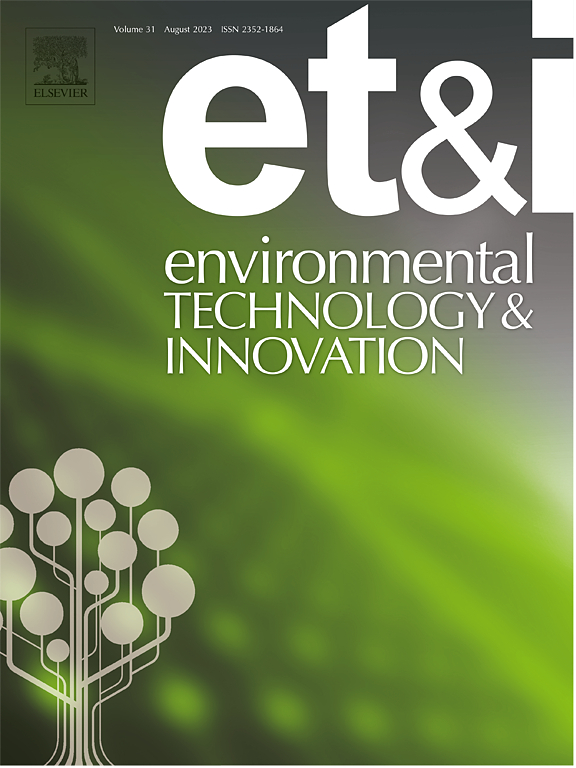Enhanced degradation of the UV filter phenylbenzimidazole sulfonic acid in water via UV-activated percarbonate
IF 6.7
2区 环境科学与生态学
Q1 BIOTECHNOLOGY & APPLIED MICROBIOLOGY
引用次数: 0
Abstract
The emergence of UV filters in aquatic environments is a significant environmental concern because of their persistent nature and potential toxicity to ecosystems. However, an efficient treatment for eliminating UV filters from water has yet to be discovered. In this study, a UV-activated sodium percarbonate (UV/SPC) process was explored for the degradation of a commonly used UV filter: phenylbenzimidazole sulfonic acid (PBSA). Owing to the synergistic effect in the UV/SPC process, PBSA was completely removed from the water within 15 minutes. On the basis of the results from the EPR and probe experiments, the reactive species •OH, CO3•–, O2•–, and 1O2 were involved in PBSA degradation. During the UV/SPC reaction, PBSA underwent several main pathways, including i) hydroxylation, ii) oxidation, iii) imidazoline ring cleavage, iv) desulfonation, and v) benzene ring cleavage, further transforming into byproducts. Moreover, no obvious Microtox® toxicity was observed after UV/SPC treatment. The crucial parameters that affected PBSA degradation were the solution pH, SPC concentration and initial PBSA concentration. In addition, the pseudo-first-order rate constant (kobs) decreased as the pH and PBSA concentration increased, whereas it increased with increasing SPC concentration. Additionally, in real water systems, PBSA was completely removed within 50 minutes by UV/SPC. In this work, comprehensive data on the mechanism of PBSA degradation and a promising treatment method for removing PBSA from water were provided.
紫外线活化过碳酸酯对水中苯并并咪唑磺酸的降解作用
由于紫外线过滤器的持久性和对生态系统的潜在毒性,在水生环境中出现的紫外线过滤器是一个重大的环境问题。然而,一种有效的去除水中紫外线过滤器的方法尚未被发现。本研究探讨了紫外活化过碳酸钠(UV/SPC)工艺对常用紫外滤料苯并并咪唑磺酸(PBSA)的降解。由于UV/SPC过程中的协同作用,PBSA在15 分钟内完全从水中去除。EPR和探针实验结果表明,•OH、CO3•-、O2•-和1O2参与了PBSA的降解。在UV/SPC反应过程中,PBSA主要经过i)羟基化、ii)氧化、iii)咪唑啉环裂解、iv)脱硫和v)苯环裂解等途径转化为副产物。此外,在UV/SPC处理后,未观察到明显的Microtox®毒性。影响PBSA降解的关键参数是溶液pH、SPC浓度和初始PBSA浓度。伪一级速率常数(kobs)随pH和PBSA浓度的增加而减小,而随SPC浓度的增加而增大。此外,在实际的水系统中,PBSA在50 分钟内被UV/SPC完全去除。本文对PBSA的降解机理进行了全面的研究,并为去除水中PBSA提供了一种有前景的处理方法。
本文章由计算机程序翻译,如有差异,请以英文原文为准。
求助全文
约1分钟内获得全文
求助全文
来源期刊

Environmental Technology & Innovation
Environmental Science-General Environmental Science
CiteScore
14.00
自引率
4.20%
发文量
435
审稿时长
74 days
期刊介绍:
Environmental Technology & Innovation adopts a challenge-oriented approach to solutions by integrating natural sciences to promote a sustainable future. The journal aims to foster the creation and development of innovative products, technologies, and ideas that enhance the environment, with impacts across soil, air, water, and food in rural and urban areas.
As a platform for disseminating scientific evidence for environmental protection and sustainable development, the journal emphasizes fundamental science, methodologies, tools, techniques, and policy considerations. It emphasizes the importance of science and technology in environmental benefits, including smarter, cleaner technologies for environmental protection, more efficient resource processing methods, and the evidence supporting their effectiveness.
 求助内容:
求助内容: 应助结果提醒方式:
应助结果提醒方式:


